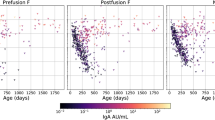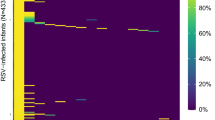Abstract
Background:
Primary respiratory syncytial virus (RSV) infections are characterized by high levels of IL-8 and an intense neutrophilia. Little is known about the cytokine responses in secondary infections. Preschool children experiencing RSV secondary infections were recruited from the siblings of infants admitted to hospital with RSV acute bronchiolitis.
Methods:
Fifty-one infants with acute bronchiolitis (39 RSV positive, 12 RSV negative) and 20 age-matched control infants were recruited. In addition, seven older siblings of infants from the RSV-positive cohort and confirmed RSV infection were recruited. Samples of nasal secretions were obtained using a flocked swab, and secretions extracted using centrifugation. Cytokine bead array was used to obtain levels of interleukin (IL)-17A, IL-8, IL-6, IL-21, and tumor necrosis factor-α.
Results:
Levels of IL-8 and IL-6 were significantly lower in the RSV-positive siblings compared with the RSV-positive infants. There were no significant differences between levels of the other cytokines in the primary and secondary infections.
Conclusion:
The very high levels of IL-8 and IL-6 response characteristic of the primary RSV infection was not observed in secondary RSV-positive infections and this did not appear to be due to a global reduction in cytokine production.
Similar content being viewed by others
Log in or create a free account to read this content
Gain free access to this article, as well as selected content from this journal and more on nature.com
or
References
Everard ML. Textbook of Paediatric Respiratory Medicine. 2nd edn. St Louis: Mosby, 2009:491–500.
Hall CB, Weinberg GA, Blumkin AK, et al. Respiratory syncytial virus-associated hospitalizations among children less than 24 months of age. Pediatrics 2013;132:e341–8.
Centers for Disease Control and Prevention (CDC). Respiratory syncytial virus activity - United States, July 2008-December 2009. MMWR Morb MortalWkly Rep 2010;30–3.
Zhou H, Thompson WW, Viboud CG, et al. Hospitalizations associated with influenza and respiratory syncytial virus in the United States, 1993-2008. Clin Infect Dis 2012;54:1427–36.
Nair H, Nokes DJ, Gessner BD, et al. Global burden of acute lower respiratory infections due to respiratory syncytial virus in young children: a systematic review and meta-analysis. Lancet 2010;375:1545–55.
Everard ML, Swarbrick A, Wrightham M, et al. Analysis of cells obtained by bronchial lavage of infants with respiratory syncytial virus infection. Arch Dis Child 1994;71:428–32.
Smith PK, Wang SZ, Dowling KD, Forsyth KD. Leucocyte populations in respiratory syncytial virus-induced bronchiolitis. J Paediatr Child Health 2001;37:146–51.
Abu-Harb M, Bell F, Finn A, et al. IL-8 and neutrophil elastase levels in the respiratory tract of infants with RSV bronchiolitis. Eur Respir J 1999;14:139–43.
Evans GS, Jones A, Qui JM et al. Neutrophil survival is prolonged in the airways of healthy infants and infants with RSV bronchiolitis. Eur Respir J 2002;20:651–7.
Viuff B, Tjørnehøj K, Larsen LE, et al. Replication and clearance of respiratory syncytial virus: apoptosis is an important pathway of virus clearance after experimental infection with bovine respiratory syncytial virus. Am J Pathol 2002;161:2195–207.
Bataki EL, Evans GS, Everard ML. Respiratory syncytial virus and neutrophil activation. Clin Exp Immunol 2005;140:470–7.
Coleman CM, Plant K, Newton S, Hobson L, Whyte MK, Everard ML. The anti-apoptotic effect of respiratory syncytial virus on human peripheral blood neutrophils is mediated by a monocyte derived soluble factor. Open Virol J 2011;5:114–23.
Lu YJ, Gross J, Bogaert D, et al. Interleukin-17A mediates acquired immunity to pneumococcal colonization. PLoS Pathog 2008;4:e1000159.
Zhang Z, Clarke TB, Weiser JN. Cellular effectors mediating Th17-dependent clearance of pneumococcal colonization in mice. J Clin Invest 2009;119:1899–909.
Moffitt KL, Gierahn TM, Lu YJ, et al. T(H)17-based vaccine design for prevention of Streptococcus pneumoniae colonization. Cell Host Microbe 2011;9:158–65.
Kimura A, Naka T, Kishimoto T. IL-6-dependent and -independent pathways in the development of interleukin 17-producing T helper cells. Proc Natl Acad Sci USA 2007;104:12099–104.
Martinez GJ, Nurieva RI, Yang XO, Dong C. Regulation and function of proinflammatory TH17 cells. Ann NY Acad Sci 2008;1143:188–211.
Hornsleth A, Klug B, Nir M, et al. Severity of respiratory syncytial virus disease related to type and genotype of virus and to cytokine values in nasopharyngeal secretions. Pediatr Infect Dis J 1998;17:1114–21.
McNamara PS, Flanagan BF, Selby AM, Hart CA, Smyth RL. Pro- and anti-inflammatory responses in respiratory syncytial virus bronchiolitis. Eur Respir J 2004;23:106–12.
Stoppelenburg AJ, de Roock S, Hennus MP, Bont L, Boes M. Elevated Th17 response in infants undergoing respiratory viral infection. Am J Pathol 2014;184:1274–9.
Faber TE, Groen H, Welfing M, Jansen KJ, Bont LJ. Specific increase in local IL-17 production during recovery from primary RSV bronchiolitis. J Med Virol 2012;84:1084–8.
Bermejo-Martin JF, Garcia-Arevalo MC, Alonso A, et al. Persistence of proinflammatory response after severe respiratory syncytial virus disease in children. J Allergy Clin Immunol 2007;119:1547–50.
Pino M, Kelvin DJ, Bermejo-Martin JF, et al. Nasopharyngeal aspirate cytokine levels 1 yr after severe respiratory syncytial virus infection. Pediatr Allergy Immunol 2009;20:791–5.
Larrañaga CL, Ampuero SL, Luchsinger VF, et al. Impaired immune response in severe human lower tract respiratory infection by respiratory syncytial virus. Pediatr Infect Dis J 2009;28:867–73.
Hall CB, Geiman JM, Biggar R, Kotok DI, Hogan PM, Douglas GR Jr . Respiratory syncytial virus infections within families. N Engl J Med 1976;294:414–9.
Glezen WP, Taber LH, Frank AL, Kasel JA. Risk of primary infection and reinfection with respiratory syncytial virus. Am J Dis Child 1986;140:543–6.
Henderson FW, Collier AM, Clyde WA Jr, Denny FW. Respiratory-syncytial-virus infections, reinfections and immunity. A prospective, longitudinal study in young children. N Engl J Med 1979;300:530–4.
Hall CB. The burgeoning burden of respiratory syncytial virus among children. Infect Disord Drug Targets 2012;12:92–7.
Henriquez KM, Hayney MS, Xie Y, Zhang Z, Barrett B. Association of interleukin-8 and neutrophils with nasal symptom severity during acute respiratory infection. J Med Virol 2015;87:330–7.
Everard ML, Milner AD. The respiratory syncitial virus and its role in acute bronchiolitis. Eur J Pediatr 1992;151:638–51.
Kinyanjui TM, House TA, Kiti MC, Cane PA, Nokes DJ, Medley GF. Vaccine induced herd immunity for control of respiratory syncytial virus disease in a low-income country setting. PLoS One 2015;10:e0138018.
Ohuma EO, Okiro EA, Ochola R, et al. The natural history of respiratory syncytial virus in a birth cohort: the influence of age and previous infection on reinfection and disease. Am J Epidemiol 2012;176:794–802.
Sande CJ, Mutunga MN, Okiro EA, Medley GF, Cane PA, Nokes DJ. Kinetics of the neutralizing antibody response to respiratory syncytial virus infections in a birth cohort. J Med Virol 2013;85:2020–5.
Modjarrad K, Giersing B, Kaslow DC, Smith PG, Moorthy VS ; WHO RSV Vaccine Consultation Expert Group. WHO consultation on respiratory syncytial virus vaccine development report from a World Health Organization meeting held on 23-24 March 2015. Vaccine 2016;34:190–7.
Cua DJ, Tato CM. Innate IL-17-producing cells: the sentinels of the immune system. Nat Rev Immunol 2010;10:479–89.
Mangodt TC, Van Herck MA, Nullens S, et al. The role of Th17 and Treg responses in the pathogenesis of RSV infection. Pediatr Res 2015;78:483–91.
Munir S, Hillyer P, Le Nouën C, et al. Respiratory syncytial virus interferon antagonist NS1 protein suppresses and skews the human T lymphocyte response. PLoS Pathog 2011;7:e1001336.
Everard ML, Fox G, Walls AF, et al. Tryptase and IgE concentrations in the respiratory tract of infants with acute bronchiolitis. Arch Dis Child 1995;72:64–9.
Bhatt JM, White C, Iqbal SM, Ritson S, Evans GS, Everard ML. Evaluation of nasal swabs for monitoring inflammation in RSV bronchiolitis. ERJ 2000;16:Suppl 31:563S.
Olivier J, Johnson WD, Marshall GD. The logarithmic transformation and the geometric mean in reporting experimental IgE results: what are they and when and why to use them? Ann Allergy Asthma Immunol 2008;100:333–7.
Author information
Authors and Affiliations
Corresponding author
PowerPoint slides
Rights and permissions
About this article
Cite this article
Ugonna, K., Douros, K., Bingle, C. et al. Cytokine responses in primary and secondary respiratory syncytial virus infections. Pediatr Res 79, 946–950 (2016). https://doi.org/10.1038/pr.2016.29
Received:
Accepted:
Published:
Issue date:
DOI: https://doi.org/10.1038/pr.2016.29
This article is cited by
-
Efficient symptomatic treatment and viral load reduction for children with influenza virus infection by nasal-spraying Bacillus spore probiotics
Scientific Reports (2023)
-
Nasal-spraying Bacillus spores as an effective symptomatic treatment for children with acute respiratory syncytial virus infection
Scientific Reports (2022)



